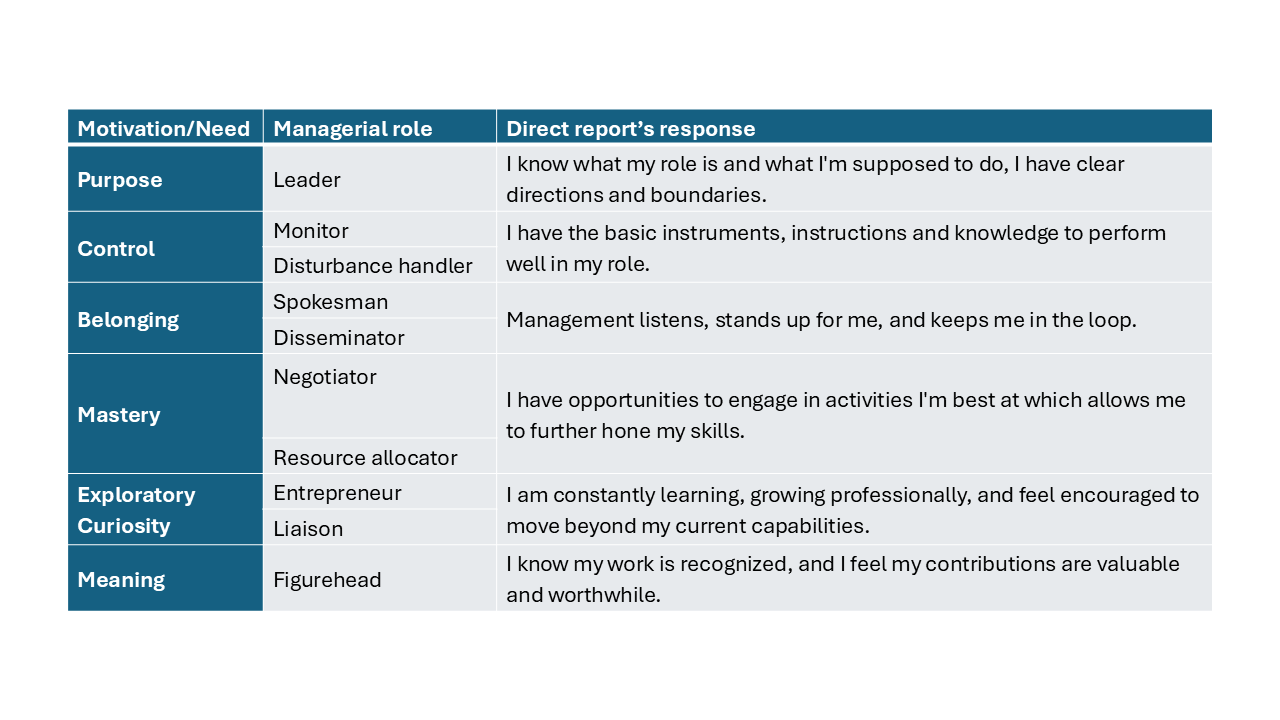Albeit differently, each manager distributes their scarce time and effort across the aforementioned roles and ensuing activities. The question is “why?” My analysis suggests that managers have — perhaps intuitively — figured out which activities deliver the desired results best and started employing these activities matter-of-factly. What's more important, they've deciphered which activities work sustainably across time. Thus, they prefer their continual practice and, as a result, certain activities show up in research data.
The purpose of each managerial role is to facilitate the attainment of typical managerial objectives. Insofar as professionals are part of the manager's team, working together toward those objectives, managerial activities arise to address the needs and wants of the group in relationship to those common objective(s).
PROFESSIONAL MOTIVATIONS
In a work setting, every professional has four fundamental motivations: Control, Belonging, Mastery and Exploratory Curiosity. In addition, the senses of Purpose and Meaning are sought after. The table below provides mapping of 10 managerial roles to six motivations: Purpose, Control, Belonging, Mastery, Exploratory Curiosity and Meaning.

Table 1. Motivations, needs and 10 managerial roles
The proverbial professional self-motivation is more likely to occur when these motivations and needs are either met, or at least not frustrated. Therefore, it is the manager's responsibility to ensure (at minimum) anti-frustration through appropriate managerial activities. So, instead of contemplating throwing another pizza party with extra cheddar cheese toppings this time, it's much more prudent to cover the basics first.
Managers often think, “Since I myself am completely capable of doing my work without a single pizza slice or lengthy pep talks — and mind you I'm just an average Jane/Joe — my direct reports should have no trouble with motivating themselves too.” And if you're the kind of manager who is very conscientious, you'd think motivation is for little babies. Duty, you'd say, is the only thing that drives results. However, what motivates you may not motivate your colleagues.
Oftentimes, managers are missing a crucial point. Their direct reports don't set or aren't allowed to set their own job-related goals. Professionals have to adjust their behaviors in accordance with objectives set by someone else. As a consequence, the key frustrations and ensuing conflicts rest with externally imposed content, collaboration and autonomy requirements. With the exception of most senior professionals who often act as managers themselves, employees typically have limited choices about which project to work on, who to work with, and how to structure their work. Managers set these conditions, requirements and standards for them — often as non-negotiables. The 10 managerial roles serve as an antidote administered to mitigate the inevitable frustrations.
CONCLUSIONS
While it may not be required for managers to get engaged in all 10 roles at once, failure to attend to direct reports' needs via such activities is likely to result in frustrated motivations. Consequently, the likelihood of lower productivity and job dissatisfaction increases, leading to a higher probability of increased voluntary turnover as well as mediocre financial performance.
Ideally, management's ultimate goal is to create a work environment conducive to professional self-motivation. Given that it is you — the manager — who sets goals and objectives, to assume that professionals will magically become self-motivated out of their own volition, and despite your managerial interventions or lack thereof, would be presumptuous indeed.






